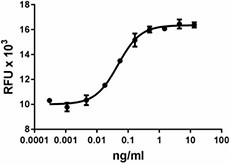- Regulatory Status
- RUO
- Other Names
- B cell growth factor 1 (BCGF-1), B-cell stimulatory factor 1 (BSF-1), interleukin-4, lymphocyte stimulatory factor 1.

-

Human IL-4 induces proliferation of TF 1 human erythroleukemic cells.
| Cat # | Size | Price | Quantity Check Availability | ||
|---|---|---|---|---|---|
| 766202 | 10 µg | $101.00 | |||
| 766204 | 25 µg | $235.00 | |||
| 766206 | 100 µg | $750.00 | |||
| 766208 | 500 µg | $2273.00 | |||
IL-4 is the primary cytokine implicated in the development of Th2-mediated responses, which is associated with allergy and asthma. IL-4 binds to two receptor complexes, the Type I receptor comprises IL-4Rα and the common gamma-chain (γc), which is also shared by the cytokines IL-2, -7, -9, -15 and -21 and is present in hematopoietic cells. IL-4 can use the type II complex, comprising IL-4Rα and IL-13Rα1, which is present in non-hematopoietic cells. This second receptor complex is a functional receptor for IL-13, which shares approximately 25% homology with IL-4. The type I receptor complex can be formed only by IL-4 and is active in Th2 development. In contrast, the type II receptor complex formed by either IL-4 or IL-13 is more active during airway hypersensitivity and mucus secretion and is not found in T cells.IL-4, through its activation of STAT6, upregulates GATA3 expression and also suppresses TH1 and TH17 cell responses, partly through the upregulation of growth factor independent 1(GFI1), a transcriptional repressor of IFNγ and IL-17 production. IL-4 induces macrophage activation and TSLP production. IL-4 recruits and activates IgE-producing B cells (IgE class switching) and enhances IgE-mediated responses by up-regulating IgE receptors on B lymphocytes, mast cells, and basophils. In addition, IL-4 also induces VCAM-1 on vascular endothelium and thus directs the migration of T lymphocytes, monocytes, basophils, and eosinophils to the inflammation site.
Product Details
- Source
- Human IL-4, amino acids (His25 – Ser153) (Accession #NM_000589) was expressed in 293E cells.
- Molecular Mass
- The 129 amino acid recombinant protein has a predicted molecular mass of approximately 14.9 kD. The DTT-reduced and non-reduced protein migrate at approximately 20 kD and 18 kD respectively by SDS-PAGE. The predicted N-terminal amino acid is His.
- Purity
- > 95% by SDS-PAGE gel as determined by Coomassie stained SDS-PAGE.
- Formulation
- 0.22 µm filtered protein solution is in PBS, pH 7.2.
- Endotoxin Level
- Less than 0.1 EU per µg (0.01 ng/µg) cytokine as determined by the LAL method.
- Concentration
- 10 and 25 µg sizes are bottled at 200 µg/mL. 100 µg size and larger sizes are lot-specific and bottled at the concentration indicated on the vial. To obtain lot-specific concentration and expiration, please enter the lot number in our Certificate of Analysis online tool.
- Storage & Handling
- Unopened vial can be stored between 2°C and 8°C for up to 2 weeks, at -20°C for up to six months, or at -70°C or colder until the expiration date. For maximum results, quick spin vial prior to opening. The protein can be aliquoted and stored at -20°C or colder. Stock solutions can also be prepared at 50 - 100 µg/mL in appropriate sterile buffer, carrier protein such as 0.2 - 1% BSA or HSA can be added when preparing the stock solution. Aliquots can be stored between 2°C and 8°C for up to one week and stored at -20°C or colder for up to 3 months. Avoid repeated freeze/thaw cycles.
- Activity
- Human IL-4 induces proliferation of TF 1 human erythroleukemic cells in a dose dependent manner. The ED50 = 0.04 - 0.2 ng/ml, corresponding to a specific activity of 0.5 -2.5 x 107 units/mg.
- Application
-
Bioassay
- Application Notes
-
BioLegend carrier-free recombinant proteins provided in liquid format are shipped on blue-ice. Our comparison testing data indicates that when handled and stored as recommended, the liquid format has equal or better stability and shelf-life compared to commercially available lyophilized proteins after reconstitution. Our liquid proteins are verified in-house to maintain activity after shipping on blue ice and are backed by our 100% satisfaction guarantee. If you have any concerns, contact us at tech@biolegend.com.
- Product Citations
-
Antigen Details
- Structure
- Heterodimer
- Distribution
-
IL-4 is produced by Th2 cells, naive CD4<sup>+</sup> T cells, NKT cells, and basophils.
- Function
- Major role in differentiation of TH2 cells and induction of Th2 associated cytokines. Suppresses TH1 and TH17 cell responses, induces macrophage activation and TSLP production, enhances IgE-mediated in B lymphocytes, mast cells, and basophils.
- Interaction
- T cells, B cells, macrophages, epithelial cells, smooth muscle cells, and bronchial fibroblasts.
- Ligand/Receptor
- IL-4 signals through Type I (IL-4Rα, γc) and Type II receptors (IL-4Rα, IL-13Rα1) complexes.
- Cell Type
- Hematopoietic stem and progenitors, Embryonic Stem Cells
- Biology Area
- Stem Cells, Immunology
- Molecular Family
- Cytokines/Chemokines
- Antigen References
-
1. Swain SL, et al. 1990. J. Immunol. 145:3796.
2. Hsieh CS, et al. 1992. Proc. Natl. Acad. Sci. USA 89:6065.
3. Allison-Lynn A, et al. 2006. J. Immunol. 176:7456.
4. Kato A, et al. 2007. J. Immunol. 179:1080.
5. LaPorte SL, et al. 2008. Cell 132:259.
6. Martinez FO, et al. 2009. Annu. Rev. Immunol. 27:451.
7. Luzina IG, et al. 2012. J. Leuko. Biol. 92:753. - Gene ID
- 3565 View all products for this Gene ID
- UniProt
- View information about IL-4 on UniProt.org
